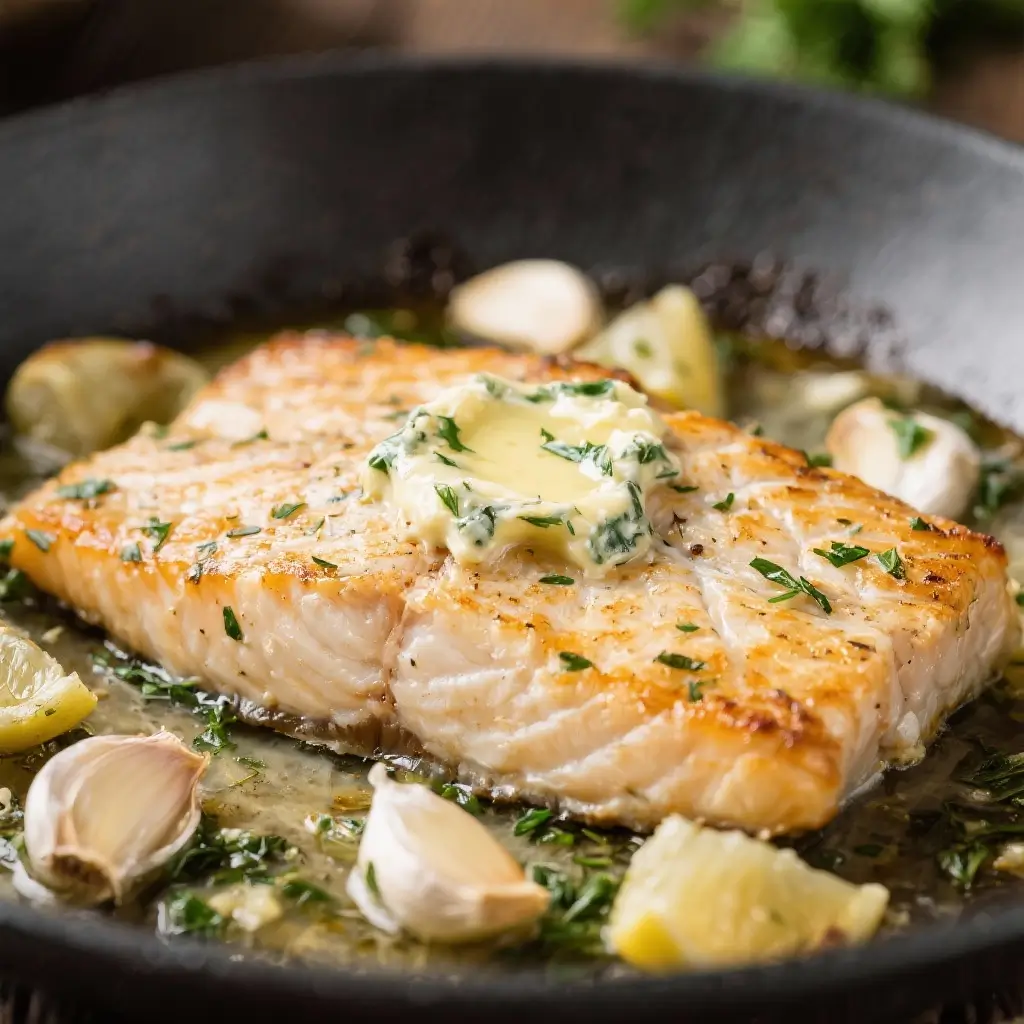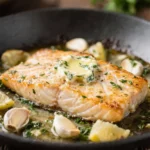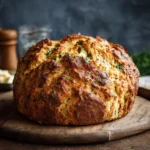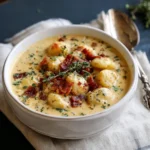Baked Mahi-Mahi with Garlic-Herb Butter
Baked Mahi-Mahi with Garlic-Herb Butter is a culinary masterpiece that combines the delicate, flaky texture of fresh mahi-mahi with the bold, aromatic flavors of garlic and a medley of fresh herbs. This dish is not only visually appealing but also nourishing, making it an ideal choice for both weeknight dinners and elegant gatherings. The buttery sauce infuses the fish with moisture and richness while enhancing its natural sweetness, creating a harmonious balance on the palate. Whether you’re a seasoned seafood enthusiast or just beginning to explore the world of fish dishes, this recipe offers a foolproof way to prepare a restaurant-quality meal at home.
The History
Mahi-mahi, whose name means “strong-strong” in Hawaiian, has long been a staple in tropical Pacific and Caribbean cuisines. Historically, coastal communities prized this firm-fleshed fish for its versatility and ability to hold up well under various cooking methods, from grilling over open flames to baking in banana leaves. With the rise of global seafood markets in the 20th century, mahi-mahi gained popularity in North America and Europe as a sustainable and flavorful alternative to overfished species like swordfish and tuna. The concept of pairing baked fish with herb-infused butter dates back to French culinary traditions, where sauces like beurre blanc and compound butters were used to elevate simple fish preparations. Over time, chefs and home cooks alike began merging these European techniques with island-inspired seasonings, giving birth to modern recipes such as Baked Mahi-Mahi with Garlic-Herb Butter—a dish that honors both tradition and innovation.
Ingredients Breakdown
The magic of this recipe lies in its carefully selected ingredients, each contributing to the overall depth of flavor, texture, and nutritional profile:
- Mahi-Mahi Fillets: Known for their mild, slightly sweet taste and firm texture, these fillets are perfect for baking without falling apart. Look for sustainably sourced, skinless fillets that are about 6–8 ounces each and roughly 1 inch thick for even cooking.
- Unsalted Butter: Using unsalted butter allows you to control the sodium content and ensures freshness. When melted, it forms the base of the herb-garlic sauce, coating the fish in luxurious richness.
- Fresh Garlic: Minced garlic adds pungency and depth. Freshly minced cloves release more aromatic compounds than pre-minced varieties, enhancing the overall savoriness of the dish.
- Fresh Herbs: A combination of parsley, dill, chives, and thyme brings brightness and complexity. Parsley contributes a clean, grassy note; dill adds a subtle anise-like aroma; chives lend mild onion flavor; and thyme offers earthy undertones.
- Lemon Juice and Zest: Fresh lemon juice cuts through the richness of the butter, while the zest intensifies citrus notes, adding vibrancy to every bite.
- Olive Oil: Used to lightly grease the baking dish and sometimes blended into the butter mixture, olive oil adds heart-healthy fats and a smooth mouthfeel.
- Seasonings: Sea salt and freshly cracked black pepper are essential for seasoning the fish and balancing the flavors. Optional additions include paprika for color and a hint of warmth or cayenne for a touch of heat.
- White Wine (Optional): A splash of dry white wine, such as Sauvignon Blanc or Pinot Grigio, can be added to the butter sauce for acidity and complexity, especially if deglazing the pan post-bake.
These ingredients come together to create a sauce that is simultaneously rich, tangy, herbal, and savory—complementing the natural qualities of the fish without overpowering them.
Step-by-Step Recipe
- Preheat the Oven: Begin by preheating your oven to 375°F (190°C). This temperature ensures gentle, even cooking that preserves the moisture of the fish without drying it out.
- Prepare the Baking Dish: Lightly grease a glass or ceramic baking dish (approximately 9×13 inches) with olive oil or non-stick spray to prevent sticking and add a subtle layer of flavor.
- Season the Fish: Pat the mahi-mahi fillets dry with paper towels to remove excess moisture, which helps the seasoning adhere better. Place them in the prepared dish, leaving space between each fillet. Season both sides generously with sea salt and freshly ground black pepper. For extra depth, sprinkle a pinch of smoked paprika or garlic powder.
- Make the Garlic-Herb Butter: In a small saucepan over low heat, melt ½ cup (1 stick) of unsalted butter. Once melted, stir in 4–5 cloves of freshly minced garlic and cook gently for 1–2 minutes until fragrant but not browned. Remove from heat and stir in 2 tablespoons fresh lemon juice, 1 teaspoon lemon zest, 2 tablespoons chopped fresh parsley, 1 tablespoon chopped fresh dill, 1 tablespoon chopped chives, and 1 teaspoon chopped fresh thyme. Mix well to combine. Optionally, add 1 tablespoon of dry white wine for additional complexity.
- Coat the Fillets: Spoon the warm garlic-herb butter evenly over each fillet, making sure to drizzle it across the surface so it seeps into any crevices. Use a pastry brush if needed to ensure full coverage.
- Bake the Fish: Transfer the baking dish to the preheated oven and bake for 15–18 minutes, depending on the thickness of the fillets. The fish is done when it flakes easily with a fork and reaches an internal temperature of 145°F (63°C). Avoid overbaking, as mahi-mahi can become dry quickly.
- Rest and Serve: Remove the fish from the oven and let it rest for 3–5 minutes. This allows the juices to redistribute throughout the fillet, ensuring maximum tenderness. Spoon any remaining butter sauce from the dish over the top before serving.
Tips
- Choose Fresh Fish: Look for fillets that are firm to the touch, have a clean ocean scent, and display a translucent, moist appearance. Avoid any with browning edges or a strong fishy odor.
- Don’t Overcook: Mahi-mahi cooks quickly. Set a timer and check early. If the flesh resists flaking, give it another minute or two. Remember, carryover cooking will continue after removal from the oven.
- Use Fresh Herbs: Dried herbs lack the vibrant flavor and aromatic oils of fresh ones. If substitutions are necessary, use one-third the amount of dried herbs (e.g., 1 teaspoon dried parsley instead of 1 tablespoon fresh).
- Add Lemon Slices: Place thin lemon slices on top of the fillets before baking for added visual appeal and slow infusion of citrus flavor.
- Enhance the Sauce: After baking, return the pan juices to a small saucepan, reduce slightly, and swirl in an extra tablespoon of cold butter for a glossy, restaurant-style finish.
- Room Temperature Start: Let refrigerated fish sit at room temperature for 10–15 minutes before baking to ensure even cooking.
- Double the Butter Mixture: If serving four or more people, consider doubling the garlic-herb butter to ensure plenty of sauce for drizzling.
Variations and Customizations
This recipe is highly adaptable to suit different tastes, dietary needs, and ingredient availability:
- Cajun-Style: Add 1 teaspoon of Cajun seasoning or Creole spice blend to the butter mixture for a spicy, smoky twist.
- Mediterranean Version: Incorporate sun-dried tomatoes, Kalamata olives, capers, and oregano into the topping for a briny, bold Mediterranean flair.
- Dairy-Free Option: Replace butter with high-quality olive oil or a plant-based butter alternative. Add a pinch of nutritional yeast for umami depth.
- Gluten-Free Friendly: This recipe is naturally gluten-free, making it suitable for those with celiac disease or gluten sensitivity—just ensure all seasonings and wines used are certified GF.
- Citrus Variations: Swap lemon for lime, orange, or yuzu juice and zest to change the flavor profile. Grapefruit pairs exceptionally well with mahi-mahi’s sweetness.
- Crumb Topping: For added texture, sprinkle panko breadcrumbs mixed with Parmesan cheese and herbs over the buttered fillets before baking for a golden crust.
- Spicy Kick: Stir in finely diced jalapeño or a few drops of hot sauce into the butter mixture for heat lovers.
- Whole Fish Alternative: While fillets are standard, you can adapt this recipe for a whole deboned mahi-mahi by increasing baking time and inserting herb bundles inside the cavity.
Health Considerations and Nutritional Value
Baked Mahi-Mahi with Garlic-Herb Butter is a nutritious option that aligns well with heart-healthy and balanced diets. Here’s a breakdown of its health benefits:
- High-Quality Protein: Mahi-mahi provides approximately 20–25 grams of lean protein per 6-ounce serving, supporting muscle repair and satiety.
- Low in Saturated Fat: The fish itself is naturally low in fat, and using moderate amounts of butter keeps the saturated fat content reasonable. Opting for olive oil can further improve the lipid profile.
- Rich in Selenium and Niacin: Mahi-mahi is an excellent source of selenium, a powerful antioxidant, and niacin (vitamin B3), which supports energy metabolism and nervous system function.
- Omega-3 Fatty Acids: While not as high in omega-3s as fatty fish like salmon, mahi-mahi still contributes beneficial fats that support brain and cardiovascular health.
- Herbs and Antioxidants: Fresh herbs like parsley and thyme are rich in flavonoids and vitamin C, offering anti-inflammatory and immune-boosting properties.
- Lemon Benefits: Citrus components aid digestion and enhance iron absorption from plant-based foods when served alongside vegetables.
- Calorie-Conscious: A single serving (fish plus 2 tablespoons of garlic-herb butter) contains approximately 280–320 calories, making it suitable for weight management plans when portion-controlled.
- Sustainable Choice: Mahi-mahi is generally considered a sustainable seafood option, particularly when caught via trolling or pole-and-line methods. Look for certifications from organizations like the Marine Stewardship Council (MSC).
To make the dish even healthier, serve it with steamed vegetables, quinoa, or a mixed green salad dressed in lemon vinaigrette.
Ingredients
- 4 mahi-mahi fillets (6–8 oz each, about 1 inch thick)
- ½ cup (1 stick) unsalted butter
- 4–5 cloves garlic, minced
- 2 tablespoons fresh lemon juice
- 1 teaspoon lemon zest
- 2 tablespoons fresh parsley, finely chopped
- 1 tablespoon fresh dill, finely chopped
- 1 tablespoon fresh chives, finely chopped
- 1 teaspoon fresh thyme leaves
- 1 tablespoon extra virgin olive oil (for greasing)
- Sea salt and freshly ground black pepper, to taste
- Optional: 1 tablespoon dry white wine
- Optional: lemon slices for garnish
Directions
- Preheat oven to 375°F (190°C). Lightly grease a 9×13-inch baking dish with olive oil.
- Pat mahi-mahi fillets dry with paper towels. Place them in the baking dish and season both sides with salt and pepper.
- In a small saucepan over low heat, melt the butter. Add minced garlic and sauté for 1–2 minutes until fragrant (do not brown).
- Remove from heat. Stir in lemon juice, lemon zest, parsley, dill, chives, thyme, and optional white wine. Mix well.
- Spoon the garlic-herb butter evenly over each fillet, covering the top surface completely.
- Bake for 15–18 minutes, or until the fish flakes easily with a fork and reaches an internal temperature of 145°F.
- Remove from oven and let rest for 5 minutes. Spoon pan juices over the fillets before serving.
- Garnish with fresh herbs and lemon slices if desired. Serve immediately.
FAQ
Can I use frozen mahi-mahi?
Yes, but thaw the fillets completely in the refrigerator overnight before baking. Never cook frozen fish directly, as it leads to uneven texture and excess moisture.
What can I substitute for mahi-mahi?
Other firm white fish like halibut, cod, sea bass, or swordfish work well with this recipe.
Can I make the butter ahead of time?
Absolutely! Prepare the garlic-herb butter up to 2 days in advance and store it in a covered container in the fridge. Reheat gently before using.
Is this dish safe for pregnant women?
Yes, mahi-mahi is low in mercury compared to other large predatory fish and is considered safe in moderation during pregnancy (1–2 servings per week).
Can I grill instead of bake?
Yes! Grill the fillets over medium heat (about 350–400°F) for 4–5 minutes per side, basting frequently with the garlic-herb butter.
How do I store leftovers?
Refrigerate in an airtight container for up to 2 days. Reheat gently in the oven or microwave to avoid overcooking.
Why did my fish turn out dry?
Overcooking is the most common cause. Always use a food thermometer and remove the fish promptly once it reaches 145°F internally.
Summary
Baked Mahi-Mahi with Garlic-Herb Butter is a flavorful, healthy, and easy-to-make dish that brings restaurant elegance to your kitchen table. With its tender fish, aromatic butter sauce, and bright citrus-herb notes, it’s sure to become a favorite for seafood lovers everywhere.










